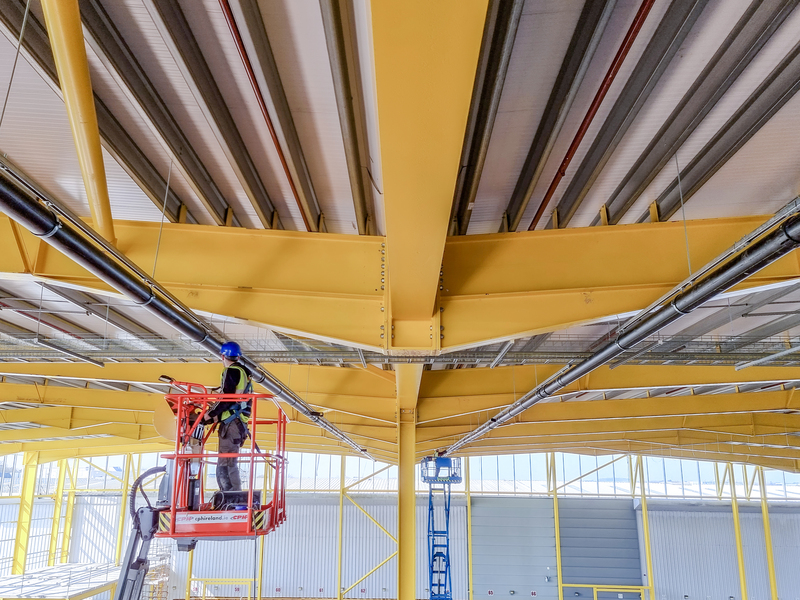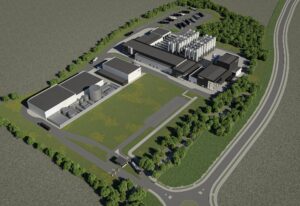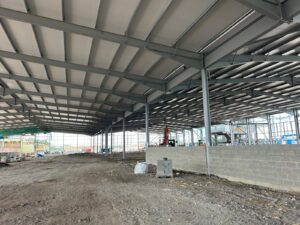The UK witnessed over £1.4 billion in flood damage last year alone. For warehouse operators and data centre managers, a single drainage failure during an intense storm can mean the difference between normal operations and catastrophic downtime. Yet despite these stakes, many industrial facilities still rely on drainage systems designed decades ago—systems that simply weren’t built for today’s extreme weather events.
Here’s the thing: modern warehouses and data centres share more than just vast roof spaces. They’re both mission-critical facilities where water ingress isn’t just inconvenient—it’s potentially devastating. The good news? We have been helping Data centres revolutionise their approach to roof drainage, and our lessons could save your warehouse from becoming another flood statistic.
Common Drainage Failures in Industrial Sites
Gravity drainage on large industrial roofs is like using a garden hose to empty a swimming pool. The physics simply don’t add up.
Traditional systems require precise slopes—typically 1:100—to function properly. Sounds reasonable until you realise that over a 200-meter warehouse span, you’d need a 25-meter drop. Most facilities compromise with minimal slopes, creating dead zones where water accumulates. Add a few autumn leaves or plastic wrapping, and those already-struggling outlets become dams.
The installation challenges compound these inherent limitations. I’ve seen warehouses where downpipes snake through storage aisles because that’s where the original designer found space. One memorable site visit revealed drainage pipes routed directly above a high-value pharmaceutical storage area—a disaster waiting to happen. Not only are these approaches impractical, but they are not aesthetically pleasing in the slightest.
But perhaps the biggest oversight? Early integration. Or rather, the lack of it. Modern warehouses evolve constantly. Racking configurations change, mezzanines appear, automation systems demand clear pathways. Yet drainage remains static, increasingly at odds with operational needs. It’s like planning a city’s roads without considering where people actually need to go. At Capcon we support clients at the earliest stages of design and planning to reduce and mitigate against later complications. Part of our ethos – being manufacturer agnostic – means that we can offer greater flexibility and tailored solutions to meet each client’s demands.
The Siphonic Advantage: Lessons from Mission Critical Buildings
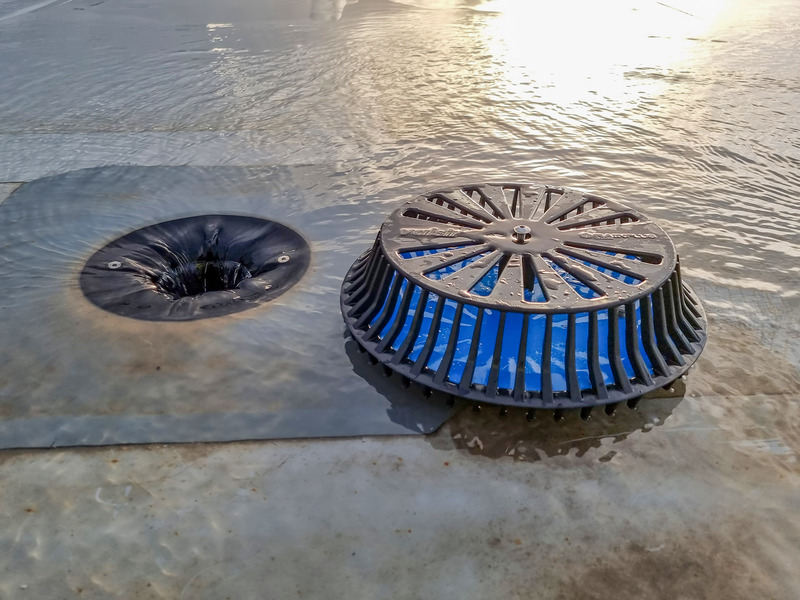
Here’s where data centres teach us something valuable. When you absolutely cannot afford water ingress, you don’t just improve traditional drainage—you rethink it entirely.
Siphonic drainage operates on a fundamentally different principle. Instead of relying on gravity and partial pipe filling, these systems create full-bore flow conditions. Imagine the difference between water trickling down a half-empty straw versus being actively pulled through a completely full tube. The vacuum effect generated means siphonic systems can achieve flow rates significantly higher than equivalent gravity systems. Not only are our siphonic drainage solutions smarter and more efficient, they look neater and make buildings more sustainable.
Take the case of a Slough data centre that faced expansion constraints. Their existing gravity drainage required 12 downpipes for a 5,000m² roof section. The siphonic replacement? Just three connection points, freeing up valuable floor space for additional server racks. More importantly, the system could handle a 1-in-100-year storm event with 40% spare capacity—the kind of overengineering that lets facility managers sleep at night.
The benefits multiply in industrial settings. Fewer penetrations through your roof membrane mean fewer potential leak points. Horizontal pipes can run at zero gradient, snaking above automated systems without clearance issues. Installation costs often prove lower too counterintuitive until you factor in reduced excavation for underground drainage and simplified pipe supports.
Consider a recent project presented by Diageo’s new €200 million brewery in Kildare—the first carbon-neutral brewery in Ireland. Designed to operate 24/7, 365 days a year, and built across a 50-acre greenfield site, the project called for innovative engineering to ensure that rainwater management aligned with a site-wide zero-carbon strategy. Capcon’s decision to deploy siphonic technology was based on three key project demands; operational continuity, spatial efficiency and carbon reduction, ultimately transforming Diageo’s rainwater systems into a strategic enabler, from vulnerable to valuable.
Retrofitting Legacy Systems: Key Considerations
Not every facility needs to rip out existing drainage tomorrow. But if you’re nodding along to any of these scenarios, it’s time for serious consideration:
Your roof ponds water for hours after rainfall. This isn’t just inconvenient—standing water accelerates membrane degradation and provides mosquito breeding grounds. One logistics operator ignored ponding until their insurance premiums jumped 30% following a risk assessment.
Building expansion is on the horizon. Adding roof area to an already-marginal drainage system is like asking a Mini to tow a caravan. I’ve seen too many expansions where drainage was an afterthought, leading to expensive post-construction modifications.
The retrofit process isn’t as daunting as many assume. Modern survey techniques—including drone mapping and 3D scanning—can assess existing conditions without operational disruption. Hydraulic modelling software then simulates various storm scenarios, identifying bottlenecks before any pipes are touched. There is also the potential to add a secondary system to get old designs up to current codes and standards to ensure your building is protected.
A School in Bognor Regis provides an instructive example. Capcon’s approach involved restoring the siphonic drainage system to full operational capacity. Blockages were cleared, and the entire system was tested to ensure efficient water flow. The restoration of this critical component was essential to preventing future water accumulation and ensuring the roof’s drainage system functioned as intended. A long-term maintenance regime was also put in place to ensure the drainage system continues to protect this school.
Designing for Resilience: Siphonic + Rainwater Harvesting
Smart facilities don’t just drain water—they manage it strategically. The marriage of siphonic drainage with rainwater harvesting represents evolution in thinking.
Here’s why this combination works: siphonic systems deliver high volumes of relatively clean roof water to collection points efficiently. Instead of overwhelming storm sewers—increasingly problematic as utilities impose discharge limits—captured water becomes an asset. Distribution centres use it for truck washing, landscape irrigation, even toilet flushing. Data centres leverage harvested water for cooling tower makeup, reducing mains water dependence. Such is the case in Asia where they are looking to sustainable solutions like rainwater harvesting to solve the pressures on existing water infrastructure where rapid population growth and urbanisation are becoming increasingly challenging to manage.
The sustainability credentials matter too. BREEAM awards significant points for rainwater management. But beyond box-ticking, there’s operational logic. A 40,000m² warehouse roof in Manchester can harvest approximately 24 million litres annually. At commercial water rates, that’s real money.
The technical integration proves surprisingly straightforward. Siphonic systems naturally concentrate flow to fewer discharge points—ideal for feeding storage tanks. Smart controls divert the first flush (containing debris) while capturing cleaner subsequent flow. One Norfolk distribution centre achieved 40% reduction in mains water use this way.
What to Look for in a Drainage Partner
Choosing a drainage specialist resembles selecting a structural engineer—technical competence is just the starting point.
Experience with similar projects proves invaluable. Look for a company whose handled complex data centre requirements and understands the stakes. They’ll propose solutions you hadn’t considered, like incorporating trace heating in outlets for freeze protection or specifying materials compatible with your industry’s specific contamination risks.
Simulation capabilities separate serious players from pipe suppliers. Modern hydraulic modelling can predict system behaviour under various scenarios—crucial for mission-critical facilities. Ask to see example outputs. Quality specialists will show pressure profiles, flow velocities, and priming sequences, not just pipe sizes.
The best certified partners think about the lifecycle, not just installation. They’ll discuss maintenance access during design, provide detailed O&M manuals, and offer training for facility teams. Some include remote monitoring options—particularly valuable for multi-site operators managing portfolio risk.
Regional expertise matters more than many realize. UK projects must comply with BS EN 12056 and BS 8490. Middle East installations often reference ASPE 45 or local adaptations. A true global partner, like Capcon should navigate these requirements fluently, managing authority approvals without drama.
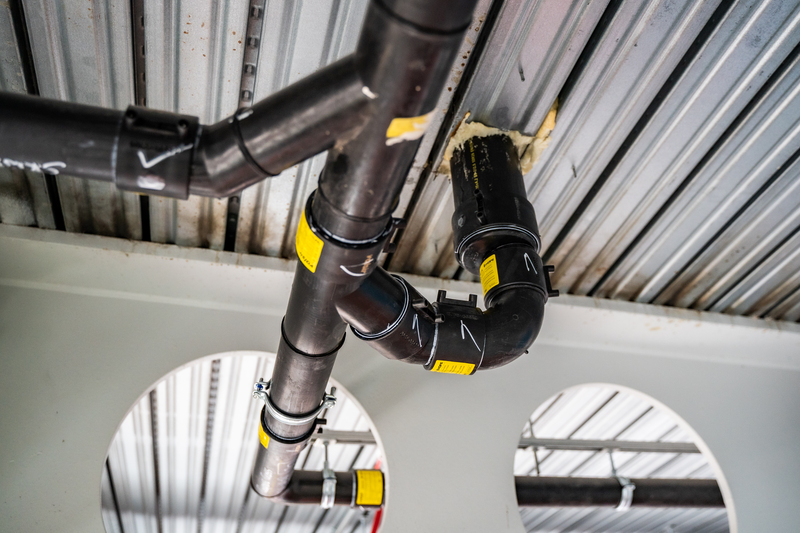
Conclusion
The convergence of climate unpredictability and operational demands has rendered traditional drainage thinking obsolete. Warehouses and data centres can no longer afford to treat roof drainage as an afterthought—it’s core infrastructure, as critical as power or fire protection.
Siphonic drainage is the proven choice for facilities that can’t afford downtime, can’t waste space, and won’t gamble with flood risk. The technology has matured, the economics make sense, and the operational benefits multiply over time.
If your facility relies on decades-old gravity drainage, you’re not just managing yesterday’s solution—you’re accepting tomorrow’s risk. The question isn’t whether to upgrade, but how quickly you can act before the next “unprecedented” storm tests your current system’s limits.
Take Action Today
Your facility’s drainage doesn’t have to be a liability waiting to happen. Capcon Engineering specialises in transforming industrial drainage from risk to reliability. Our engineers have designed and installed siphonic solutions for data centres, distribution hubs, and manufacturing facilities across the Europe, UK, Asia and Middle East.
Book a consultation with Capcon Engineering for a site-specific review. We’ll assess your current drainage capacity, model potential upgrades, and demonstrate exactly how modern siphonic systems can protect your operations while reducing costs.
Don’t wait for the next storm to reveal your drainage vulnerabilities.
Contact us today to schedule your professional drainage assessment.
*Images for illustrative purposes only
References
- https://www.abi.org.uk/news/news-articles/2025/2/more-action-needed-to-protect-properties-as-adverse-weather-takes-record-toll-on-insurance-claims-in-2024/
- https://www.insurancejournal.com/news/international/2025/02/11/811581.htm
- https://www.abi.org.uk/news/news-articles/2024/4/weather-damage-insurance-claims-worst-on-record/
- https://www.reinsurancene.ws/record-573m-paid-out-in-weather-related-home-insurance-claims-in-2023-abi/
- https://www.itv.com/news/2024-04-14/record-573m-paid-out-in-weather-related-home-insurance-claims-in-2023-abi
- https://www.gov.uk/government/publications/flood-forecasting-centre-annual-review-2023-to-2024/flood-forecasting-centre-annual-review-2023-to-2024
- https://www.internetgeography.net/storm-babet-case-study/
- https://news.leeds.gov.uk/news/leeds-flood-defences-perform-as-designed-during-storm-babet
- https://floodlist.com/europe/floods-england-scotland-storm-babet-october-2023
- https://8point9.com/severe-flooding-on-river-idle-from-storm-babet/
- https://www.gov.uk/government/news/rolling-news-story-flooding-from-storm-babet
- https://www.pwc.co.uk/press-room/press-releases/insurance-costs-of-storm-babet-initially-estimated-to-be-between.html
- https://www.abi.org.uk/news/news-articles/2023/12/weathering-the-storm/
- https://en.wikipedia.org/wiki/Storm_Babet
- https://www.gov.uk/government/news/east-midlands-one-year-on-from-storm-babet
- https://a816-dohbesp.nyc.gov/IndicatorPublic/data-stories/flooding-and-health/
- https://www.nyc.gov/site/cdbgdr/hurricane-sandy/hurricane-sandy.page
- https://www.datacenterknowledge.com/archives/2012/11/01/ny-data-centers-battle-back-from-storm-damage
- https://www.informationweek.com/it-sectors/hurricane-sandy-surge-challenges-nyc-data-centers
- https://www.datacenterknowledge.com/archives/2012/10/30/major-flooding-nyc-data-centers
- https://adage.com/article/media/hurricane-sandy-knocks-huffpo-buzzfeed-gawker/238044
- https://abcnews.go.com/Technology/hurricane-sandy-takes-york-city-data-center-gawker/story?id=17601425
- https://money.cnn.com/2012/10/30/technology/sandy-internet-outage
- https://techcrunch.com/2012/10/29/hurricane-sandy-attacks-the-web-gawker-buzzfeed-and-huffington-post-are-down/
- https://www.mylearning.org/index.php/stories/what-happens-when-it-floods/1132
- https://www.mylearning.org/stories/what-happens-when-it-floods/1132
- https://www.yorkshireeveningpost.co.uk/news/leeds-boxing-day-floods-looking-back-on-the-day-that-changed-our-city-forever-241968
- https://en.wikipedia.org/wiki/2015%E2%80%9316_Great_Britain_and_Ireland_floods
- https://www.techmonitor.ai/hardware/data-centres/severe-floods-in-leeds-hit-vodafone-data-centre-4767027
- https://www.leeds.gov.uk/planning/planning-policy/local-plan-update/flood-risk
- https://www.datacenterdynamics.com/en/news/vodafone-uk-data-center-suffers-outage-due-to-floods/
- https://www.silicon.co.uk/cloud/floods-vodafone-data-centre-leeds-182967
- https://www.yorkshirepost.co.uk/news/crime/police-flood-hit-yorkshire-want-answers-over-communications-failures-1804595
- https://www.vedantu.com/physics/density-of-water
- https://kg-m3.com/material/water
- https://www.engineeringtoolbox.com/water-density-specific-weight-d_595.html
- https://www.iapws.org/release.html
- https://www.iapws.org/relguide/IAPWS-95.html
- https://yorkshirefloodresilience.co.uk/tools-resources/the-real-story/flood-risk-management-in-leeds-the-real-story
- https://news.leeds.gov.uk/news/senior-councillors-to-consider-storm-eva-floods-response-report-update

